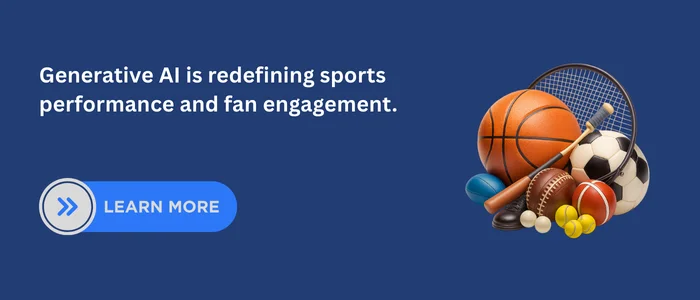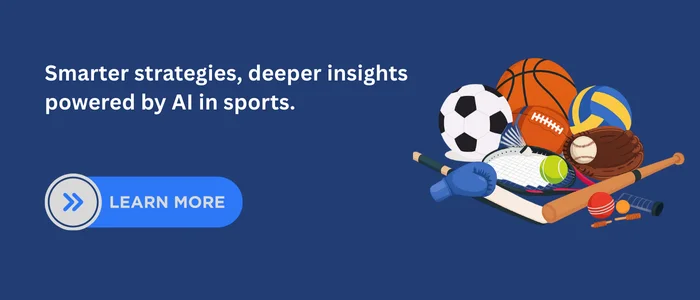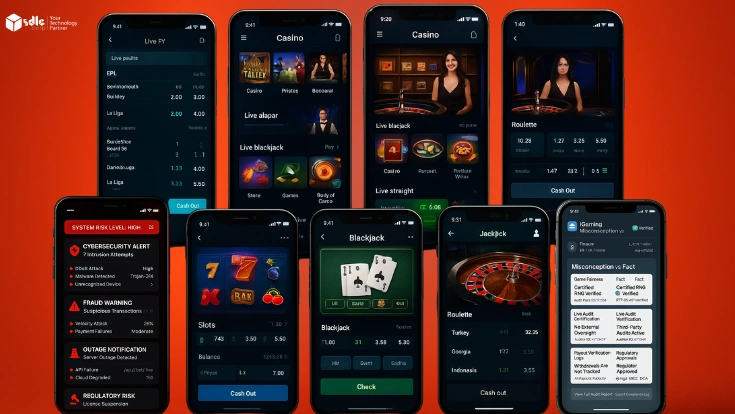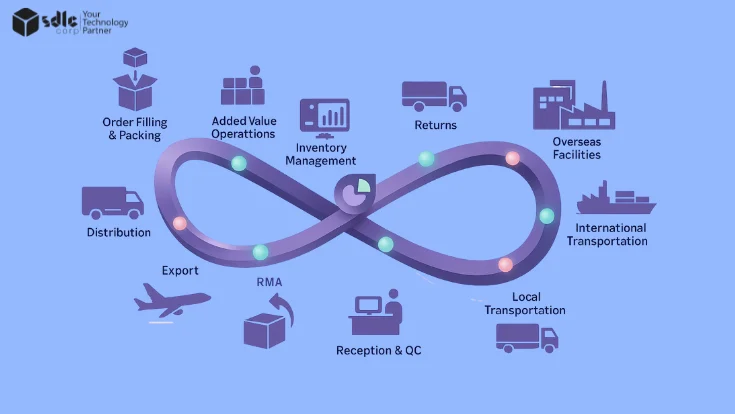Introduction
The sports industry is undergoing a generative AI revolution, transforming how athletes train, how teams compete, and how fans engage. Unlike traditional analytics, generative AI leverages deep learning, neural networks, and predictive modeling to create hyper-realistic simulations, personalized training programs, and advanced scouting systems. By adopting AI Development Solution, sports organizations are shifting from reactive data analysis to proactive performance optimization unlocking new possibilities in athlete development, injury prevention, tactical decision-making, and fan engagement. This convergence of sports technology and artificial intelligence is establishing new industry benchmarks for performance, innovation, and competitive advantage.
1. Advanced Performance Analytics: Unlocking Athletic Potential Through AI
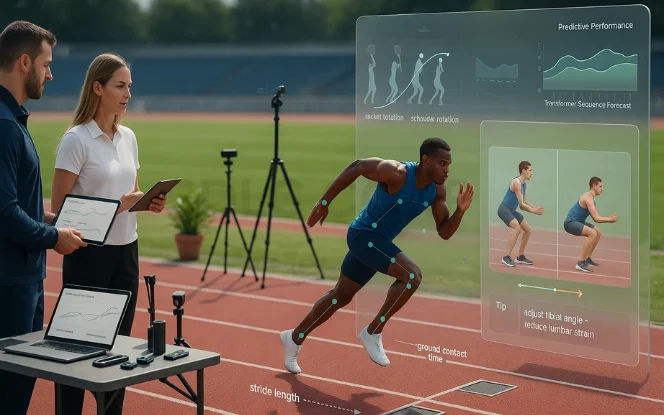
Biomechanical Analysis & Movement Optimization
AI-powered biomechanical analysis is giving coaches insights once invisible to the human eye. Deep learning systems process thousands of movement sequences, detecting inefficiencies in running, striking, or throwing techniques.
For example, computer vision algorithms break down motion frame by frame, helping athletes refine form while minimizing injury risk. Generative simulations even allow trainers to test adjustments virtually reducing strain and optimizing results before changes hit the field.
Predictive Performance Modeling
Generative AI doesn’t just analyze the present; it forecasts the future. By combining historical performance data, training loads, and environmental factors, predictive models anticipate outcomes such as fatigue, injury likelihood, and recovery timelines.
This empowers coaches to tailor training intensity, optimize schedules, and prevent burnout. For instance, NBA teams have begun piloting AI fatigue models that predict when players should rest to extend career longevity.
2. Intelligent Talent Identification and Recruitment Strategies
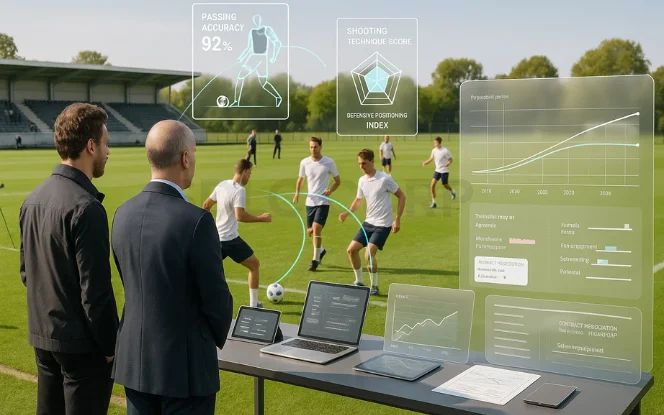
Data-Driven Scouting & Player Evaluation
Scouting has long been influenced by subjective judgment, but Generative AI in Sports Technology makes evaluations far more data-driven and precise. By analyzing performance data, psychological traits, and tactical intelligence, AI systems create holistic player profiles that reduce bias and improve recruitment accuracy.
AI-Powered Scouting: Evaluates technical skills, fitness, and tactical awareness from large datasets.
NLP Insights: Uses natural language processing to analyze scouting reports, match commentary, and even social media for hidden signals.
Computer Vision Analysis: Reviews game footage frame by frame to assess passing accuracy, shooting mechanics, and defensive positioning.
Balanced Evaluation: AI complements traditional human scouting, making decisions more objective and reliable.
Example: Premier League clubs have already deployed AI scouting tools to spot emerging talent before competitors.
Market Value Prediction & Contract Optimization
Beyond identifying talent, AI in sports is revolutionizing how teams negotiate contracts and assess market value. With generative valuation models, executives can predict an athlete’s worth by combining performance data with commercial potential such as merchandise sales or global fan engagement.
Valuation Models: Forecast player worth using injury history, performance metrics, and career trajectory.
Machine Learning Algorithms: Study transfer trends, salary caps, and long-term performance depreciation.
Economic & Marketing Modeling: Incorporate fan engagement, sponsorship opportunities, and merchandising into player valuations.
Smarter Contract Negotiations: Provide executives with reliable data for roster planning and financial optimization.
Example: Top European football clubs leverage AI-driven contract models to balance performance with commercial revenue opportunities.
Read Also : Generative AI for Sports
3. Ethical Considerations and Responsible AI Implementation in Sports
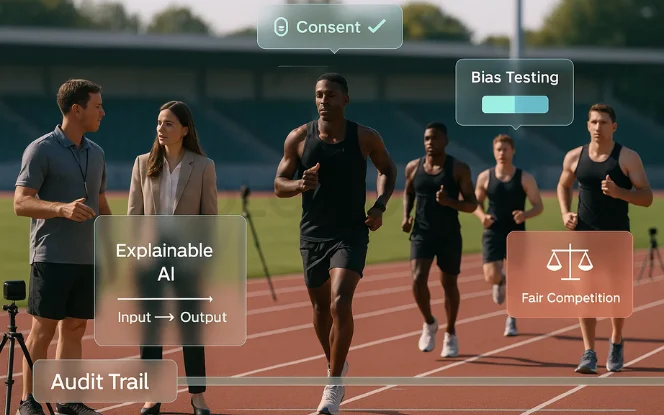
Data Privacy & Athlete Rights Protection
As Generative AI in Sports Technology expands, the issue of athlete privacy and rights has become central. AI systems rely on massive amounts of sensitive data from biometric scans to performance analytics and mishandling this information can compromise both trust and compliance. Sports organizations must therefore embed strong governance frameworks and transparent policies to protect athletes while enabling innovation.
Comprehensive Data Governance: Secure storage and management of biometric data, performance metrics, and personal identifiers.
Explicit Consent Mechanisms: Transparent communication around what data is collected, how it is used, and how long it is stored.
Data Ownership & Monetization: Athletes should have clear rights over their own data, including compensation models and third-party sharing agreements.
Cross-border sports competitions introduce additional complexity. Regulations such as GDPR and HIPAA demand strict compliance, making it essential for leagues to establish global data frameworks. Beyond compliance, there is also an ethical dimension: athletes must understand how their physiological data trains AI systems and supports commercial applications. Ensuring that data use is fair, transparent, and consensual is critical for building long-term trust.
Cross-Border Compliance: Navigate GDPR, HIPAA, and international privacy laws.
Ethical Utilization of Data: Ensure athletes are aware of how their data powers AI systems and business applications.
Algorithmic Bias & Fair Competition Standards
As Generative AI in Sports Technology becomes central to scouting and performance, fairness is a critical concern. AI models can unintentionally inherit biases from training data favoring certain demographics, geographies, or playing styles. To protect athletes and maintain competitive balance, organizations must adopt safeguards that ensure equitable opportunities.
Bias Detection Protocols: Regularly test AI models for demographic, socioeconomic, or style-based bias.
Equitable Recruitment: Use AI to promote fairness in athlete evaluation across regions and diverse populations.
Bias Mitigation Strategies: Train AI on diverse datasets and apply fairness-aware machine learning methods.
Sports bodies must also maintain competitive integrity by standardizing AI access across leagues. Regulatory oversight will be essential to guarantee transparency and fairness, ensuring that AI enhances competition rather than creating disproportionate advantages.
Integrity Safeguards: Standardize AI access to prevent unequal advantages.
Regulatory Oversight: Establish frameworks for transparency and accountability in AI use.
Transparency & Explainability in AI Decision-Making
For AI adoption in sports to succeed, trust and explainability are non-negotiable. Coaches, athletes, and executives need to understand not only the recommendations AI makes but also why those recommendations were made.
Explainable AI (XAI) Models: Offer interpretable outputs that coaches and athletes can act upon confidently.
Simplified Interfaces: Translate complex neural network logic into user-friendly dashboards.
Audit Trails: Maintain detailed records of AI-driven decisions for accountability and compliance.
Clear explainability ensures stakeholders trust AI while satisfying regulators. A balanced approach is key maintaining transparency without sacrificing accuracy or performance. When athletes and staff can see how AI reaches its conclusions, adoption becomes smoother and more impactful.
Trust & Accountability: Visibility into AI reasoning builds confidence and compliance.
Balanced Performance: Combine accuracy with explainability to maximize effectiveness.
4. Revolutionary Injury Prevention and Sports Medicine Applications
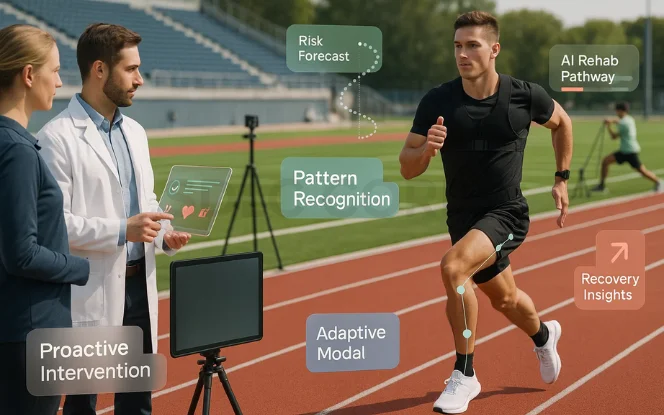
Predictive Risk Assessment & Proactive Intervention
Injuries are one of the biggest threats to an athlete’s career and a team’s success. With Generative AI in Sports Medicine, organizations can move from reactive treatment to proactive prevention. By processing biomechanical patterns, training loads, physiological markers, and even environmental conditions, AI can forecast risks before they turn into injuries.
Generative AI in Sports Medicine: Analyzes complex datasets to identify early signs of injury risk.
Advanced Pattern Recognition: Detects subtle changes in muscle activation, movement quality, or fatigue levels that traditional methods often miss.
What makes this powerful is the ability to enable proactive medical intervention. Sports physicians and trainers can act before symptoms appear reducing downtime, cutting rehabilitation costs, and protecting long-term athlete health.
Proactive Medical Intervention: Helps medical staff step in early to prevent serious injuries.
Adaptive Machine Learning Models: Continuously refine protocols through real-time monitoring, ensuring every athlete gets a personalized prevention strategy.
Example: Several NFL and European football teams are already piloting wearable AI devices that track fatigue and predict potential injuries, helping reduce player downtime by weeks.
Personalized Rehabilitation & Recovery Optimization
Recovery is just as important as performance, and Generative AI in Sports Medicine is making rehabilitation smarter and more personalized. Instead of one-size-fits-all treatment plans, AI tailors recovery programs to each athlete by analyzing injury-specific parameters, individual profiles, and ongoing healing progress.
Custom AI-Generated Rehab Pathways: Create dynamic recovery programs aligned with an athlete’s needs and progress.
Reinforcement Learning Algorithms: Adjust therapy intensity in real time based on milestones and patient responses.
Wearable technology adds another powerful layer. By tracking real-time physiological and biomechanical data, AI can fine-tune rehabilitation exercises, preventing re-injury and ensuring steady improvement.
Wearable Sensor Integration: Collects live data on movement quality, stress levels, and healing progress.
Data-Driven Recovery Insights: Delivers actionable analytics to medical staff, helping optimize return-to-play timelines.
Example: Elite European football clubs are now equipping athletes with AI-driven wearables that monitor micro-movements during rehab, cutting recovery time and reducing repeat injuries.
5. Enhanced Fan Engagement Through AI-Generated Content
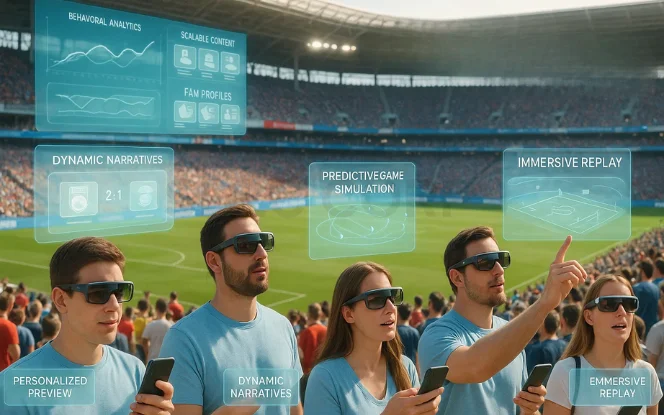
Personalized Content Creation & Interactive Experiences
In today’s digital-first era, fans expect more than just highlight reels. Generative AI in Sports Technology is enabling organizations to deliver hyper-personalized content at scale from tailored match previews to interactive narratives that resonate with different audiences.
Natural Language Generation (NLG) models can automatically create player-focused stories, statistical breakdowns, and match reports adapted to individual fan profiles. By combining this with behavioral data analytics, AI systems analyze social media interactions, viewing habits, and engagement trends to fine-tune content that feels personal and relevant.
NLG Models: Generate customized previews, reports, and fan-centric storylines.
Behavioral Data Analytics: Track fan behavior to deliver truly personalized experiences.
Scalability is another major advantage. AI tools allow sports media outlets to automate content creation across massive audiences while still maintaining relevance. Advanced models can even spin the same event into different narrative styles for example, producing a stat-heavy breakdown for analysts and an emotional storyline for casual fans.
Scalable Content Generation: Cuts costs while enhancing reach.
Dynamic Content Variations: Creates multiple storytelling formats for different demographics.
Example: ESPN and major European football clubs are already experimenting with AI-driven highlight reels that adjust tone, length, and emphasis based on the fan’s interests.
Virtual & Augmented Reality (VR/AR) Integration
Generative AI in Sports Technology is revolutionizing how fans and athletes experience games through VR and AR integration. Instead of being passive viewers, fans can now immerse themselves in predictive simulations, historical match recreations, and interactive training modules. These AI-generated synthetic environments add a new dimension to sports engagement.
For fans, the appeal lies in immersive spectator engagement. From 360° replays and tactical overlays to unique player viewpoints, VR and AR provide perspectives that traditional broadcasts cannot match. Meanwhile, machine learning ensures these experiences are tailored creating personalized VR environments that reflect individual viewing habits, favorite players, and engagement patterns.
AI-Generated Synthetic Environments: Simulations, match recreations, and interactive training modules.
Immersive Spectator Engagement: New perspectives like player viewpoints, tactical overlays, and 360° replays.
Personalized VR Experiences: Customized content based on fan data and behavior.
Athletes and coaches also benefit. Predictive modeling in AR/VR enables teams to test alternative game strategies, run scenario-based simulations, and even create educational modules to train players more effectively. By merging performance analytics with immersive technology, AR and VR are becoming strategic tools both on and off the field.
Predictive Modeling in AR/VR: Explore game strategies, simulations, and training content.
Example: NBA franchises have piloted VR-powered tactical reviews, letting players study defensive formations from immersive, first-person viewpoints.
Read This : What is Generative AI?
6. Real-Time Strategic Decision Support Systems
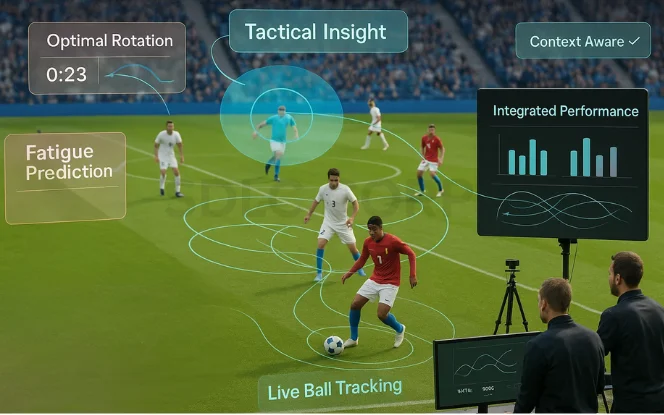
Dynamic Tactical Analysis & Game Strategy Optimization
Winning in competitive sports often comes down to split-second decisions. Generative AI in Sports Technology empowers coaches with real-time tactical analysis, transforming live data streams into actionable insights. By monitoring opponent behavior, player positioning, and overall game flow, AI enhances a coach’s ability to make smarter, faster adjustments during high-pressure moments.
Generative AI in Coaching: Processes live data to provide immediate tactical recommendations.
Machine Learning Algorithms: Optimize substitutions, formation changes, and tactical shifts to maximize performance.
Speed and precision are critical. With edge computing integration, AI delivers ultra-low-latency insights, ensuring that tactical adjustments reach coaches instantly. Meanwhile, data-driven adaptability provides continuous monitoring of ball movement, player positioning, and performance metrics, helping teams stay agile as the game evolves.
Edge Computing Integration: Provides lightning-fast decision support for coaches.
Data-Driven Adaptability: Enhances in-game strategies by tracking real-time performance indicators.
Example: Just as Formula 1 teams use AI to optimize pit-stop strategies mid-race, football and basketball teams are adopting real-time AI analytics to fine-tune tactics during matches.
Performance Monitoring & In-Game Optimization
Broadcasting is no longer just about showing the game it’s about creating immersive, personalized experiences for audiences across platforms. Generative AI in Sports Technology is reshaping the way content is produced, distributed, and consumed by fans worldwide.
AI-powered broadcasting systems generate real-time overlays, predictive graphics, and tailored viewing experiences based on audience preferences. Combined with natural language processing (NLP), broadcasters can automatically produce match reports, highlight reels, and even social media content cutting production time while maintaining editorial accuracy.
AI-Powered Broadcasting Systems: Create real-time stats, predictive visuals, and personalized fan experiences.
NLP for Content Automation: Delivers highlights, reports, and reels at scale with speed and accuracy.
Cross-platform content delivery is another breakthrough. AI can produce multiple versions of the same broadcast optimized for TV, mobile, and social media ensuring relevance for different demographics. Meanwhile, computer vision algorithms assist with intelligent camera switching and optimal shot selection, ensuring fans always see the most engaging angles.
Cross-Platform Content Variation: Produces tailored outputs for diverse platforms, saving time and cost.
Computer Vision Algorithms: Capture the most impactful broadcast moments automatically.
Finally, machine learning feedback loops refine workflows by analyzing fan engagement data, ensuring every broadcast gets smarter over time.
Machine Learning Feedback Loops: Continuously optimize broadcasts using viewer analytics and consumption trends.
Example: During the FIFA World Cup, broadcasters tested AI-driven highlight systems that automatically clipped key plays and shared them across social platforms within minutes.
7.Advanced Broadcasting and Media Production Technologies
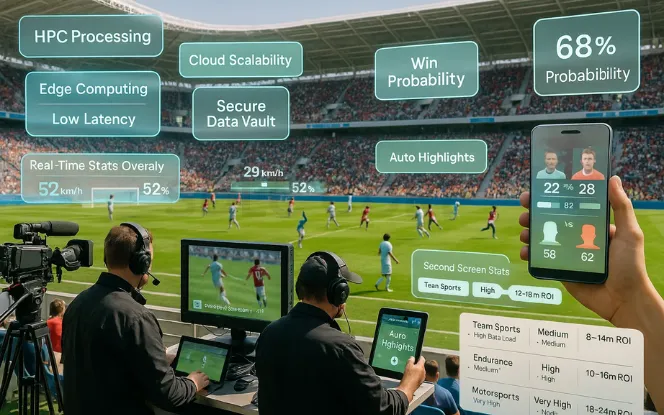
Automated Content Generation & Production Workflows
Behind the scenes, sports broadcasting and content production are being transformed by Generative AI in Sports Technology. Instead of relying solely on manual editing, AI automates repetitive tasks, speeds up turnaround times, and ensures that fans get fresh, personalized content across platforms.
Modern broadcasting systems powered by AI create real-time overlays, predictive graphics, and personalized experiences tuned to audience data. Meanwhile, Natural Language Processing (NLP) automates the production of match reports, highlight reels, and social media snippets with editorial precision freeing up human creators to focus on storytelling.
AI-Powered Broadcasting Systems: Deliver stats, visuals, and predictive content instantly.
NLP Automation: Produces reports, highlights, and social content at scale.
Generative AI also makes it possible to produce cross-platform content variations, ensuring the same event looks different on TV, mobile, or social feeds. Computer vision algorithms further optimize workflows by enabling intelligent camera switching, ensuring the best broadcast angles are always captured.
Cross-Platform Content Variation: Optimizes outputs for TV, mobile, and social audiences.
Computer Vision Algorithms: Automates camera selection for the most engaging visuals.
Finally, machine learning feedback loops close the circle analyzing audience behavior to continuously improve future workflows. This ensures production teams keep refining content in real time, meeting fan expectations with efficiency and accuracy.
Machine Learning Feedback Loops: Use viewer engagement data to refine production quality.
Example: Broadcasters during the NBA Playoffs used AI-driven systems to instantly generate platform-specific highlight reels one version optimized for Instagram reels, another for full YouTube recaps.
Interactive Broadcasting & Second-Screen Experiences
Sports fans today want more than a passive viewing experience. With Generative AI in Sports Technology, broadcasters are enhancing engagement through interactive content and second-screen applications that bring fans closer to the action.
Generative AI enables real-time interactivity, providing predictive analytics, contextual storytelling, and on-demand insights while a game unfolds. At the same time, second-screen applications deliver personalized statistics, tactical breakdowns, and player comparisons tailored to each viewer’s profile.
Generative AI-Driven Interactivity: Adds predictive insights and real-time storytelling to live broadcasts.
Second-Screen Applications: Provide custom stats, tactical analysis, and player comparisons for fans.
The experience goes further with adaptive content delivery. By analyzing user behavior and engagement history, AI dynamically adjusts what fans see from personalized highlights to different viewing perspectives. Broadcasters can also leverage AI-customized commentary, generating alternate tracks that focus on stats, tactical detail, or fan-favorite narratives.
Adaptive Content Delivery: Personalizes broadcasts in real time based on preferences.
AI-Customized Commentary: Creates tailored commentary for different fan journeys.
The ultimate result is enhanced fan engagement, boosting satisfaction, retention, and loyalty across multiple platforms.
Enhanced Fan Engagement: Strengthens audience retention with personalized and interactive experiences.
Example: During the NFL season, broadcasters tested AI-powered second-screen apps that allowed fans to track player stats in real time while following the live broadcast.
8.Implementation Considerations and Technical Requirements
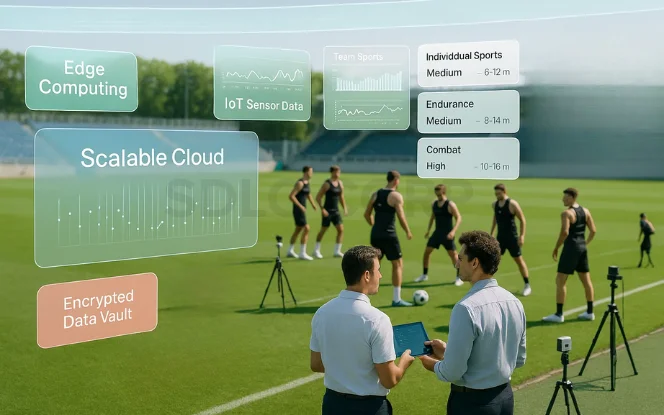
Infrastructure & Technology Stack Requirements
Building the foundation for Generative AI in Sports Technology requires more than algorithms — it demands a robust infrastructure that can handle massive data streams, real-time analytics, and secure deployment. Sports organizations investing in AI must focus on both performance and reliability to ensure smooth adoption.
At the core, high-performance computing (HPC) and scalable cloud platforms are essential. They allow teams to process high-velocity sports data streams, store workloads across distributed environments, and deploy models in real time. Frameworks like TensorFlow and PyTorch provide the backbone for running deep learning architectures that power generative AI.
High-Performance Computing (HPC): Processes large-scale, high-speed sports data.
Scalable Cloud Platforms: Enable storage, deployment, and real-time processing of AI workloads.
Specialized ML Frameworks: Leverage TensorFlow, PyTorch, or custom tools for generative AI.
Equally important is data integration and edge computing. By consolidating IoT sensor feeds, video tracking systems, and external databases, AI models gain a holistic view of athlete performance. Edge solutions reduce latency, delivering real-time insights that can guide on-field decisions instantly.
Data Integration Systems: Bring together IoT, video, and external databases.
Edge Computing Solutions: Reduce latency for real-time tactical analytics.
Finally, performance must be matched with security. Network optimization ensures high throughput and system stability, while data security and governance protect sensitive athlete data through encryption, compliance, and access control frameworks.
Network Optimization: Maintains high-speed, reliable system performance.
Data Security & Governance: Safeguards sensitive data with encryption and compliance protocols.
Example: Professional leagues are now deploying hybrid cloud + edge infrastructures to balance real-time in-game analytics with secure off-field data storage.
Comparative Analysis of AI Implementation Across Sports Disciplines
| Sport Category | Primary AI Applications | Data Processing Requirements | Implementation Complexity | ROI Timeline |
|---|---|---|---|---|
| Team Sports (Football, Basketball) | Real-time strategy optimization, player tracking, tactical analysis | High-frequency positional data, video streams, biometric sensors | High | 12–18 months |
| Individual Sports (Tennis, Golf) | Performance biomechanics, technique optimization, predictive modeling | Motion capture, environmental sensors, historical performance data | Medium | 6–12 months |
| Endurance Sports (Cycling, Marathon) | Pacing strategies, physiological monitoring, nutrition optimization | Continuous biometric data, GPS tracking, environmental conditions | Medium | 8–14 months |
| Combat Sports (Boxing, MMA) | Strike analysis, injury prevention, training optimization | High-speed video analysis, impact sensors, recovery metrics | High | 10–16 months |
| Motorsports (Formula 1, NASCAR) | Vehicle telemetry, race strategy, predictive maintenance | Real-time telemetry, weather data, tire performance metrics | Very High | 18–24 months |
Staff Training & Change Management
No matter how advanced the technology, success in Generative AI in Sports Technology depends on people. Coaches, analysts, and IT professionals must be equipped to interpret AI insights and integrate them into daily workflows. That’s why AI education programs are essential, ensuring staff can confidently apply AI-driven recommendations in real-world contexts.
AI Education Programs: Upskill coaches, analysts, and IT staff to effectively use AI insights.
Human-AI Collaboration: Position AI as a partner, with human judgment guiding final decisions.
Adopting new technologies also requires cultural change. Sports organizations must build change management frameworks that address skepticism and clearly communicate AI’s role as an enhancement, not a replacement. At the same time, staff need to be aware of system limitations including bias risks, oversight requirements, and the importance of ethical use.
Change Management Frameworks: Reduce adoption resistance by emphasizing AI as supportive, not disruptive.
System Limitations Awareness: Educate staff on AI risks, biases, and ethical constraints.
Finally, sustainable success comes from continuous learning. Ongoing professional development keeps teams aligned with the latest AI advancements, while human capital investment builds long-term organizational literacy. This ensures that AI integration creates not just short-term wins, but lasting competitive advantage.
Continuous Professional Development: Regular training aligned with evolving AI tools.
Human Capital Investment: Building AI literacy drives sustainable advantage in sports.
Example: Several European football clubs now run in-house AI training workshops for coaches, ensuring tactical AI insights are seamlessly integrated into match-day strategies.
Technology Investment Framework
| Implementation Phase | Technology Components | Estimated Investment Range | Timeline | Key Success Metrics |
|---|---|---|---|---|
| Foundation Setup | Data infrastructure, cloud platforms, basic sensors | $500K – $2M | 3–6 months | Data collection accuracy, system uptime |
| AI Model Development | Machine learning platforms, algorithm development, initial training | $1M – $5M | 6–12 months | Model accuracy, prediction reliability |
| Integration & Testing | System integration, user interfaces, pilot programs | $750K – $3M | 4–8 months | User adoption rates, performance improvements |
| Full Deployment | Complete rollout, staff training, optimization | $500K – $2M | 3–6 months | ROI achievement, competitive advantage metrics |
| Ongoing Operations | Maintenance, updates, continuous improvement | $200K – $1M annually | Continuous | System performance, innovation pipeline |
Conclusion
Generative AI is revolutionizing sports performance, strategy, and fan engagement, enabling smarter decision-making and deeper personalization. As machine learning, predictive modeling, and neural networks advance, AI-driven insights will become increasingly accurate and transformative. Organizations that invest in AI Development Services through robust infrastructure, skilled talent, and data governance will gain sustainable competitive advantages while safeguarding athlete welfare and authentic fan experiences. The future of sports technology lies in automation, intelligent optimization, and immersive engagement where AI enhances performance without replacing the human spirit that makes sports truly compelling.
FAQs
1. What are the main applications of generative AI in sports?
Generative AI powers performance analytics, injury prevention, talent scouting, fan engagement, real-time strategy, and automated broadcasting workflows.
2. How does generative AI improve athlete performance analysis?
It uses deep learning and biomechanical data to detect inefficiencies, predict performance trajectories, and simulate training scenarios reducing injury risks.
3. How does machine learning help prevent sports injuries?
ML analyzes training loads, biomechanics, physiology, and environment to predict risks early, enabling proactive interventions and customized prevention protocols.
4. How do sports organizations use AI for fan engagement?
Through NLG, VR/AR, and predictive content, AI delivers personalized match previews, interactive simulations, and multi-format content tailored to diverse audiences.
5. What infrastructure is needed for AI in sports?
Key requirements: high-performance computing, cloud platforms, edge computing, ML frameworks, strong data security, and staff training.
6. How does AI impact real-time coaching and strategy?
AI systems provide instant tactical insights, formation shifts, and substitution timing using live data streams with edge computing for minimal latency.

